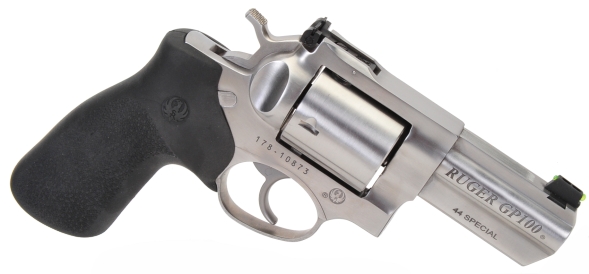
The Ruger GP100, as tested with a variety of factory ammo, put up good number in terms of velocity, accuracy and penetration in Part 1. If there was more to finesse out of the combination, it would be with a focus on getting a bit more velocity and a bit more penetration and full expansion without exceeding the 44 Special’s 15,500 psi SAAMI pressure limit. In other words, get a bit more performance without attempting to make the 44 Special into a 44 Magnum. Pushing the cartridge to higher pressure, besides being unsafe, would lose the easy shooting personality of the 44 Special.
A brief factory ammo recap of Part 1… 168 hours earlier
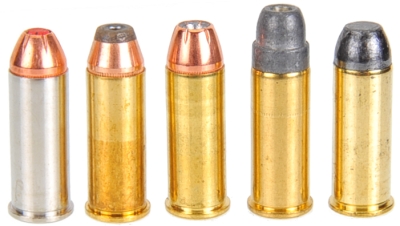
| Ammunition | Bullet Type |
Bullet Grains |
Rated FPS |
Actual FPS |
Gel Depth” |
50 Ft 5 Shot Groups” |
| Hornady Critical Duty | FTX | 165 | 900 | 927 | 12 | 2.0 |
| PMC Bronze | JHP | 180 | 980 | 746 | 18 1/2 | 2.1 |
| Hornady Custom | JHP | 180 | 1000 | 780 | 24 1/2 | 1.6 |
| Federal Champion | SWC HP | 200 | 870 | 765 | 32+ | 1.7 |
| Winchester Cowboy Action | Lead FN | 240 | 750 | 646 | 32+ | 2.3 |
With the exception of Hornady Critical Duty, which is rated with a 2.5″ vented barrel standard, the barrel length used to establish manufacturers’ ratings is 7.5″ and vented. The Ruger GP100 44 Special barrel measures 3.080″ muzzle to cylinder face, so the difference would be anticipated.
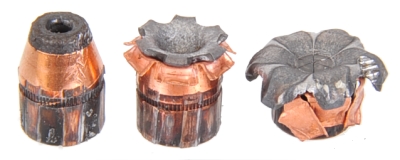
Three bullets were recovered from ballistic gel at the depth indicated on the table above. L-R Hornady Custom 100% weight retention and no expansion, PMC Bronze 100% weight retention and 0.568″ expanded diameter, Hornady Critical Duty 161 grains retained weight and expanded to a diameter of 0.714″. I did not recover Federal or Winchester lead as they penetrated 32″+ of FBI standard gel blocks and were nowhere to be found in the dirt backstop.
For 90% of all application, there is a selection within the five factory loads tested, but there are many other choices for the 44 Special from: Barnes, Buffalo Bore, Cor-Bon, DT Tactical, and Speer. For the most part they are loaded with 180 to 240 grain and are penetrating rounds and handy to have around if a black bear or cougar saw you as a chew toy.
The best 44 Special bullets are not 44 Magnum bullets…
I did notice within this population of ammunition, all brands have at least one load that utilizes one of the two 44 Special specific bullets pictured below. For this project, it was easier to handload using these component bullets and circumvent the obstacles of ammunition inventory outages and cartridge costs that ranged as high as two dollars per round. Yee Hah!
There is a relatively narrow range of expanding bullets made specifically for the 44 Special, as opposed to light weight bullets made for the 44 Magnum that usually end up in 44 Special factory ammo. 44 Special bullets should be lighter in construction to expand properly at lower than magnum velocity, a lighter construction that would not compliment magnum level velocity. This is especially true where the revolver barrel length is below 4″.

Above and far left, a Barnes TAC-XP 44 Special component bullet. They are a 0.429″ diameter, 200 Grain Hollow Point and Lead-Free. Approx $33.49/40. Next, a Speer Gold Dot 44 Special component bullet, 0.429″ diameter, 200 Grain Bonded Jacketed Hollow Point. Approx $30.49/100. On the right side of the frame, a nose down look at the same bullets to illustrate thinness of construction.
Sure, there are at least twenty types of powder that could be used and would provide a moving 44 Special bullet, but not necessarily with optimal accuracy and not without spitting up half the charge as unburned powder. Most of the newer low copper fouling, reduced flash powders are also low on energy and produce quite modest velocity. So I settled on Alliant Power Pistol and Alliant Unique.
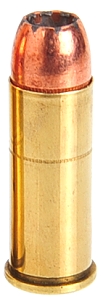 |
Warning: Bullet selections are specific, and loads are not valid with substitutions of different bullets of the same weight. Variations in bullet length will alter net case capacity, pressure and velocity. Primer selection is specific and primer types are not interchangeable. These are maximum loads in my firearms and may easily be excessive in others. All loads should be reduced by 5%, and developed following safe handloading practices as represented in established reloading manuals produced by component manufacturers. Presentation of these loads does not constitute a solicitation for their use, nor a recommendation.
|
||||||||||||||||||||||||||||||||||||||||||||||||||||||||||||||||||||||
|
|||||||||||||||||||||||||||||||||||||||||||||||||||||||||||||||||||||||

Penetration and expansion results were interesting… The Speer bullet at 919 fps blew through 32″ of FBI standard gel blocks, then floated another foot before falling to the ground. The thin petals expanded to 0.891″ and only shed 1.8 grains of bullet weight. The Barnes bullet penetrated 22 1/2″ of gel, did not expand at all, retained all of its weight, and only deformed at the rifling coined striations. The Speer bullet had terrific penetration and expansion. The Barnes bullet, as something made for lower 44 Special velocity? I could have just loaded inexpensive cast or any other lower cost 44 Mag bullet and gotten as much or more penetration and at a significantly lower per round cost.
I guess my ammunition conclusions are – In factory ammunition, the Hornady Critical Duty FTX 165 performed as a solid home defense. Penetration was adequate without over penetration, expansion was excellent and it was a soft shooting round. For out in the woods hunting or… ambling, Federal Champion SWC HP 200 grain cast bullet loads were accurate, deep penetrating and easy to shoot accurately. For handloads, the Speer 200 grain Gold Dot for home defense, but loaded down a bit to reduce penetration. As a hunting, hiking or fishing side arm, I think I would go with any 200 grain to 240 grain cast SWC bullet that would have serious penetration and let the 0.429″ bullet diameter do the job and not worry about expansion.
I will own this gun and name it Stubby…
The Ruger GP100 44 Special has a great deal of personality; compact, big bore and with authoritative power, but without producing shooting hand whiplash, sore wrists or a headache. It is light in a belt holster and compact enough to conceal on anyone but a fat guy on a bicycle in Spandex.
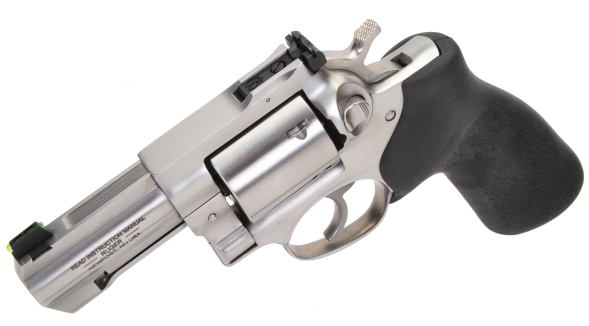
I do not see the GP100 44 causing the 357 magnum version to fade away in medium to long barrel lengths, but I do see it giving the 357 magnum a run for its money in short barrel configurations, in open and concealed carry and for home defense. It is well made and stout as would be expected from Ruger and it is a nice looking revolver.

Email Notification